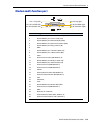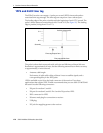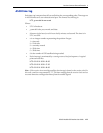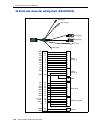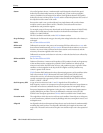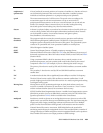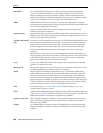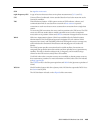
SPSx51 Modular GPS Receivers User Guide 181
Glossary
emphemeris /
ephemerides
A list of predicted (accurate) positions or locations of satellites as a function of time. A
set of numerical parameters that can be used to determine a satellite’s position.
Available as broadcast ephemeris or as postprocessed precise ephemeris.
epoch The measurement interval of a GPS receiver. The epoch varies according to the
measurement type: for real-time measurement it is set at one second; for
postprocessed measurement it can be set to a rate of between one second and one
minute. For example, if data is measured every 15 seconds, loading data using
30-second epochs means loading every alternate measurement.
feature A feature is a physical object or event that has a location in the real world, which you
want to collect position and/or descriptive information (attributes) about. Features
can be classified as surface or non-surface features, and again as points,
lines/breaklines, or boundaries/areas.
firmware The program inside the receiver that controls receiver operations and hardware.
GLONASS Global Orbiting Navigation Satellite System. GLONASS is a Soviet space-based
navigation system comparable to the American GPS system. The operational system
consists of 21 operational and 3 non-operational satellites in 3 orbit planes.
GNSS Global Navigation Satellite System.
GSOF General Serial Output Format. A Trimble proprietary message format.
HDOP Horizontal Dilution of Precision. HDOP is a DOP value that indicates the accuracy of
horizontal measurements. Other DOP values include VDOP (vertical DOP) and PDOP
(Position DOP).
Using a maximum HDOP is ideal for situations where vertical precision is not
particularly important, and your position yield would be decreased by the vertical
component of the PDOP (for example, if you are collecting data under canopy).
L1 The primary L-band carrier used by GPS and GLONASS satellites to transmit satellite
data.
L2 The secondary L-band carrier used by GPS and GLONASS satellites to transmit
satellite data.
L2C A modernized code that allows significantly better ability to track the L2 frequency.
L5 The third L-band carrier used by GPS satellites to transmit satellite data. L5 will
provide a higher power level than the other carriers. As a result, acquiring and tracking
weak signals will be easier.
Moving Base Moving Base is an RTK positioning technique in which both reference and rover
receivers are mobile. Corrections are sent from a “base” receiver to a “rover” receiver
and the resultant baseline (vector) has centimeter-level accuracy.
MSAS MTSAT Satellite-Based Augmentation System. A satellite-based augmentation system
(SBAS) that provides a free-to-air differential correction service for GPS. MSAS is the
Japanese equivalent of WAAS, which is available in the United States.
multipath Interference, similar to ghosts on an analog television screen, that occurs when GPS
signals arrive at an antenna having traversed different paths. The signal traversing the
longer path yields a larger pseudorange estimate and increases the error. Multiple
paths can arise from reflections off the ground or off structures near the antenna.
NMEA National Marine Electronics Association. NMEA 0183 defines the standard for
interfacing marine electronic navigational devices. This standard defines a number of
'strings' referred to as NMEA strings that contain navigational details such as positions.
Most Trimble GPS receivers can output positions as NMEA strings.







